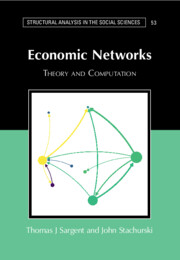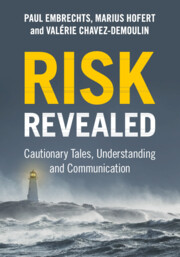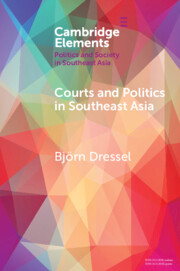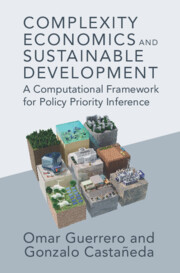326 results
11 - Conclusions
- from Part VI - Conclusion
-
-
- Book:
- Informal Governance in World Politics
- Published online:
- 23 May 2024
- Print publication:
- 30 May 2024, pp 267-271
-
- Chapter
- Export citation
2 - The Miracle Makers
- from Part I - No Mere Incantation
-
- Book:
- Ruins to Riches
- Published online:
- 12 April 2024
- Print publication:
- 09 May 2024, pp 35-56
-
- Chapter
- Export citation

Economic Networks
- Theory and Computation
-
- Published online:
- 11 April 2024
- Print publication:
- 25 April 2024

Risk Revealed
- Cautionary Tales, Understanding and Communication
-
- Published online:
- 05 April 2024
- Print publication:
- 11 April 2024
Gendering Late Medieval Habsburg Dynastic Politics: Maximilian I and His Social Networks
-
- Journal:
- Austrian History Yearbook , First View
- Published online by Cambridge University Press:
- 25 March 2024, pp. 1-16
-
- Article
-
- You have access
- Open access
- HTML
- Export citation
Chapter 1 - Paris
- from I - Place
-
-
- Book:
- Wagner in Context
- Published online:
- 14 March 2024
- Print publication:
- 14 March 2024, pp 11-19
-
- Chapter
- Export citation

Courts and Politics in Southeast Asia
-
- Published online:
- 11 March 2024
- Print publication:
- 04 April 2024
-
- Element
- Export citation
What Is a Society? Building an Interdisciplinary Perspective and Why That's Important
-
- Journal:
- Behavioral and Brain Sciences / Accepted manuscript
- Published online by Cambridge University Press:
- 23 February 2024, pp. 1-72
-
- Article
- Export citation
3 - Bank Atrophy and Outliers
-
- Book:
- Silicon Valley Bank
- Published online:
- 08 February 2024
- Print publication:
- 15 February 2024, pp 40-77
-
- Chapter
- Export citation
High school financial education courses in the United States.: What is the importance of setting state policies?
-
- Journal:
- Journal of Financial Literacy and Wellbeing / Volume 1 / Issue 3 / October 2023
- Published online by Cambridge University Press:
- 15 February 2024, pp. 431-449
-
- Article
-
- You have access
- Open access
- HTML
- Export citation
Credit networks and business dynamics in a viceregal capital: Santafé de Bogotá in the age of Charles III
-
- Journal:
- Financial History Review / Volume 30 / Issue 3 / December 2023
- Published online by Cambridge University Press:
- 12 February 2024, pp. 330-354
-
- Article
- Export citation
Concentration of measure for graphon particle system
- Part of
-
- Journal:
- Advances in Applied Probability , First View
- Published online by Cambridge University Press:
- 19 January 2024, pp. 1-28
-
- Article
-
- You have access
- Open access
- HTML
- Export citation
From Bad Student to Transnational Activist: Netiwit Chotiphatphaisal and Transnational Activism in Northeast and Southeast Asia
-
- Journal:
- TRaNS: Trans-Regional and -National Studies of Southeast Asia , First View
- Published online by Cambridge University Press:
- 19 January 2024, pp. 1-16
-
- Article
-
- You have access
- Open access
- HTML
- Export citation
Chapter 3 - Unique Collections of the Ordines from Worms, Wissembourg, St Amand and St Gallen
- from Part I - Compilation and Content of the Manuscripts
-
- Book:
- Roman Liturgy and Frankish Creativity
- Published online:
- 04 January 2024
- Print publication:
- 18 January 2024, pp 52-68
-
- Chapter
- Export citation
5 - The Networks
- from Part I - The Colours of Power
-
- Book:
- Power and Inequality
- Published online:
- 04 January 2024
- Print publication:
- 18 January 2024, pp 99-122
-
- Chapter
- Export citation
1 - Introduction
-
- Book:
- Power and Inequality
- Published online:
- 04 January 2024
- Print publication:
- 18 January 2024, pp 1-8
-
- Chapter
-
- You have access
- HTML
- Export citation
Abnormal intrinsic brain functional network dynamics in first-episode drug-naïve adolescent major depressive disorder
-
- Journal:
- Psychological Medicine / Volume 54 / Issue 8 / June 2024
- Published online by Cambridge University Press:
- 04 January 2024, pp. 1758-1767
-
- Article
- Export citation

Complexity Economics and Sustainable Development
- A Computational Framework for Policy Priority Inference
-
- Published online:
- 04 January 2024
- Print publication:
- 25 January 2024
Reengineering of interbank networks
-
- Journal:
- Network Science / Volume 12 / Issue 1 / March 2024
- Published online by Cambridge University Press:
- 18 December 2023, pp. 41-64
-
- Article
-
- You have access
- Open access
- HTML
- Export citation
5 - Political Behavior under Household Cooperation
- from Part II - The Patriarchal Political Order
-
- Book:
- The Patriarchal Political Order
- Published online:
- 30 November 2023
- Print publication:
- 14 December 2023, pp 119-132
-
- Chapter
- Export citation



